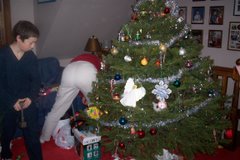As I began to read, I had no problem when they started off by saying that removing the sod was one of the most difficult parts of digging. I ignored the fact that I would be happy to have sod to remove instead of the weird bushy roots we have. We only have sod in places that we've fertilized heavily. I pushed to the back of my mind that sod removal would have been the easiest part for me. I brushed over my observation that they didn't have any real photographs and the diagrams didn't show a single rock being dug out. Then I was even okay when the book said that you must dig down two feet. I told myself that it was alright because I had dug down at least a foot and in one bed it was probably a foot and a half.
What came next in no way resembled what I had done in my garden. In my garden, after digging a huge hole, I added a thick layer of semi decayed wood chips. The thickness of the wood chips varied depending on how deep the hole was. Then I began to add a combination of the original soil, peat moss and cow manure. I threw in a bit of pellet fertilizer as well. I alternated materials and mixed and fluffed and mixed and fluffed some more until I was sweating like a pig. (Sweating is a new thing for me that has developed now that I'm in my forties) In the end I had a bed of the best soil I've ever had.
What the author had written was that I should have been carefully removing the soil as to not disturb the natural layers...they may have used the word striations and I think that means layers but the more I think about it, I'm not sure. What I am sure of is that I was not careful and I knew I must have messed up those "striations", whatever they may be. As a matter of fact, since I was adding so much cow manure, peat moss and wood chips, I removed the worst clumps of clay, threw them into a wheel barrow and dumped it as far away from the hole as possible! If that didn't mess up those striations, I don't know what would!
Then, I'm not sure but I don't think they even mentioned anything about adding material to the bottom of the hole! Again, I guess that would disturb those striations. After all, soil doesn't randomly have a layer of wood chips a foot below the surface! I planted carrots in the first bed I prepared and now I'm thinking there could be problems. What if the carrots grow down and suddenly come to those wood chips? Will they panic and scream out "where are the striations?" On the other hand, if they make it that far, they would be three times as long as any carrots that I've ever grown and I wouldn't really care if they stopped growing. In fact, they may think "this is different; I love the quirkiness of that woman."
So, as I was reading what I should have done, my eyes began to glaze over. Erin walked by, pleased that I was reading the book she gave me, and asked "do you like it?" I replied that it was a bit complicated but I still enjoyed reading it. She said that she had noticed that it seemed complicated. What I said is true and although I like to read all gardening books, I always find that my version of doing things never matches what I should be doing. Maybe that's why I have so many failures...

1 comment:
The problem with reading gardening books is finding 2 that agree completely on methods, LOL.
Anyway, it sounds to me like you did something right, so don't let that book get you down. If you're happy with your results by summer's end, then rinse and repeat for next year.
A lot depends on the original ground you have to work with. We have lots of clay also and you can't just leave it like that.
Post a Comment